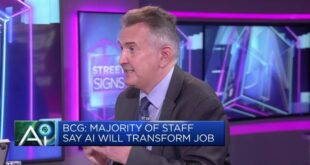WHETHER IBM IS STAYING WITHIN U.S. age laws as it cuts from and adds to its workforce turns largely on how and why the company chooses individuals to be eliminated. While executives say they never target older workers, internal company documents and interviews suggest otherwise.
Consider, for example, a planning presentation that former IBM executives said was drafted by heads of a business unit carved out of IBM’s once-giant software group and charged with pursuing the “C,” or cloud, portion of the company’s CAMS strategy.
The presentation laid out plans for substantially altering the unit’s workforce. It was shown to company leaders including Diane Gherson, the senior vice president for human resources, and James Kavanaugh, recently elevated to chief financial officer. Its language was couched in the argot of “resources,” IBM’s term for employees, and “EP’s,” its shorthand for early professionals or recent college graduates.
Among the goals: “Shift headcount mix towards greater % of Early Professional hires.”
Among the means: “[D]rive a more aggressive performance management approach to enable us to hire and replace where needed, and fund an influx of EPs to correct seniority mix.”
Among the expected results: “[A] significant reduction in our workforce of 2,500 resources.”
A slide from a similar presentation prepared last spring for the same leaders called for “re-profiling current talent” to “create room for new talent.” Presentations for 2015 and 2016 for the 50,000-employee software group also included plans for “aggressive performance management” and emphasized the need to “maintain steady attrition to offset hiring.”
IBM declined to answer questions about whether either presentation was turned into company policy. The description of the planned moves matches what hundreds of older ex-employees told ProPublica they believe happened to them: They were ousted because of their age. The company used their exits to hire replacements, many of them young; to ship their work overseas; or to cut its overall headcount.
Ed Alpern, now 65, of Austin, started his 39-year run with IBM as a Selectric typewriter repairman. He ended as a project manager in October of 2016 when, he said, his manager told him he could either leave with severance and other parting benefits or be given a bad job review — something he said he’d never previously received — and risk being fired without them.
Albert Poggi, now 70, was a three-decade IBM veteran and ran the company’s Palisades, New York, technical center where clients can test new products. When notified in November of 2016 he was losing his job to layoff, he asked his bosses why, given what he said was a history of high job ratings. “They told me,” he said, “they needed to fill it with someone newer.”
The presentations from the software group, as well as the stories of ex-employees like Alpern and Poggi, square with internal documents from two other major IBM business units. The documents for all three cover some or all of the years from 2013 through the beginning of 2018 and deal with job assessments, hiring, firing and layoffs.
The documents detail practices that appear at odds with how IBM says it treats its employees. In many instances, the practices in effect, if not intent, tilt against the company’s older U.S. workers.
For example, IBM spokespeople and lawyers have said the company never considers a worker’s age in making decisions about layoffs or firings.
But one 2014 document reviewed by ProPublica includes dates of birth. An ex-IBM employee familiar with the process said executives from one business unit used it to decide about layoffs or other job changes for nearly a thousand workers, almost two-thirds of them over 50.
Documents from subsequent years show that young workers are protected from cuts for at least a limited period of time. A 2016 slide presentation prepared by the company’s global technology services unit, titled “U.S. Resource Action Process” and used to guide managers in layoff procedures, includes bullets for categories considered “ineligible” for layoff. Among them: “early professional hires,” meaning recent college graduates.
This slide, from an invitation-only IBM conference in New York in December 2014, suggests that the company’s future success in marketing emerging technologies depended on how well it understood and embraced the generation born after 1980.
In responding to age-discrimination complaints that ex-employees file with the EEOC, lawyers for IBM say that front-line managers make all decisions about who gets laid off, and that their decisions are based strictly on skills and job performance, not age.
But ProPublica reviewed spreadsheets that indicate front-line managers hardly acted alone in making layoff calls. Former IBM managers said the spreadsheets were prepared for upper-level executives and kept continuously updated. They list hundreds of employees together with codes like “lift and shift,” indicating that their jobs were to be lifted from them and shifted overseas, and details such as whether IBM’s clients had approved the change.
An examination of several of the spreadsheets suggests that, whatever the criteria for assembling them, the resulting list of those marked for layoff was skewed toward older workers. A 2016 spreadsheet listed more than 400 full-time U.S. employees under the heading “REBAL,” which refers to “rebalancing,” the process that can lead to laying off workers and either replacing them or shifting the jobs overseas. Using the job search site LinkedIn, ProPublica was able to locate about 100 of these employees and then obtain their ages through public records. Ninety percent of those found were 40 or older. Seventy percent were over 50.
IBM frequently cites its history of encouraging diversity in its responses to EEOC complaints about age discrimination. “IBM has been a leader in taking positive actions to ensure its business opportunities are made available to individuals without regard to age, race, color, gender, sexual orientation and other categories,” a lawyer for the company wrote in a May 2017 letter. “This policy of non-discrimination is reflected in all IBM business activities.”
But ProPublica found at least one company business unit using a point system that disadvantaged older workers. The system awarded points for attributes valued by the company. The more points a person garnered, according to the former employee, the more protected she or he was from layoff or other negative job change; the fewer points, the more vulnerable.
The arrangement appears on its face to favor younger newcomers over older veterans. Employees were awarded points for being relatively new at a job level or in a particular role. Those who worked for IBM for fewer years got more points than those who’d been there a long time.
The ex-employee familiar with the process said a 2014 spreadsheet from that business unit, labeled “IBM Confidential,” was assembled to assess the job prospects of more than 600 high-level employees, two-thirds of them from the U.S. It included employees’ years of service with IBM, which the former employee said was used internally as a proxy for age. Also listed was an assessment by their bosses of their career trajectories as measured by the highest job level they were likely to attain if they remained at the company, as well as their point scores.
The tilt against older workers is evident when employees’ years of service are compared with their point scores. Those with no points and therefore most vulnerable to layoff had worked at IBM an average of more than 30 years; those with a high number of points averaged half that.
Perhaps even more striking is the comparison between employees’ service years and point scores on the one hand and their superiors’ assessments of their career trajectories on the other.
Along with many American employers, IBM has argued it needs to shed older workers because they’re no longer at the top of their games or lack “contemporary” skills.
But among those sized up in the confidential spreadsheet, fully 80 percent of older employees — those with the most years of service but no points and therefore most vulnerable to layoff — were rated by superiors as good enough to stay at their current job levels or be promoted. By contrast, only a small percentage of younger employees with a high number of points were similarly rated.
“No major company would use tools to conduct a layoff where a disproportionate share of those let go were African Americans or women,” said Cathy Ventrell-Monsees, senior attorney adviser with the EEOC and former director of age litigation for the senior lobbying giant AARP. “There’s no difference if the tools result in a disproportionate share being older workers.”
In addition to the point system that disadvantaged older workers in layoffs, other documents suggest that IBM has made increasingly aggressive use of its job-rating machinery to pave the way for straight-out firings, or what the company calls “management-initiated separations.” Internal documents suggest that older workers were especially targets.
Like in many companies, IBM employees sit down with their managers at the start of each year and set goals for themselves. IBM graded on a scale of 1 to 4, with 1 being top-ranked.
Those rated as 3 or 4 were given formal short-term goals known as personal improvement plans, or PIPs. Historically many managers were lenient, especially toward those with 3s whose ratings had dropped because of forces beyond their control, such as a weakness in the overall economy, ex-employees said.
But within the past couple of years, IBM appears to have decided the time for leniency was over. For example, a software group planning document for 2015 said that, over and above layoffs, the unit should seek to fire about 3,000 of the unit’s 50,000-plus workers.
To make such deep cuts, the document said, executives should strike an “aggressive performance management posture.” They needed to double the share of employees given low 3 and 4 ratings to at least 6.6 percent of the division’s workforce. And because layoffs cost the company more than outright dismissals or resignations, the document said, executives should make sure that more than 80 percent of those with low ratings get fired or forced to quit.
Finally, the 2015 document said the division should work “to attract the best and brightest early professionals” to replace up to two-thirds of those sent packing. A more recent planning document — the presentation to top executives Gherson and Kavanaugh for a business unit carved out of the software group — recommended using similar techniques to free up money by cutting current employees to fund an “influx” of young workers.
In a recent interview, Poggi said he was resigned to being laid off. “Everybody at IBM has a bullet with their name on it,” he said. Alpern wasn’t nearly as accepting of being threatened with a poor job rating and then fired.
Alpern had a particular reason for wanting to stay on at IBM, at least until the end of last year. His younger son, Justin, then a high school senior, had been named a National Merit semifinalist. Alpern wanted him to be able to apply for one of the company’s Watson scholarships. But IBM had recently narrowed eligibility so only the children of current employees could apply, not also retirees as it was until 2014.
Alpern had to make it through December for his son to be eligible.
But in August, he said, his manager ordered him to retire. He sought to buy time by appealing to superiors. But he said the manager’s response was to threaten him with a bad job review that, he was told, would land him on a PIP, where his work would be scrutinized weekly. If he failed to hit his targets — and his managers would be the judges of that — he’d be fired and lose his benefits.
Alpern couldn’t risk it; he retired on Oct. 31. His son, now a freshman on the dean’s list at Texas A&M University, didn’t get to apply.
“I can think of only a couple regrets or disappointments over my 39 years at IBM,”” he said, “and that’s one of them.”
 EU News Digest Latest News & Updates
EU News Digest Latest News & Updates



